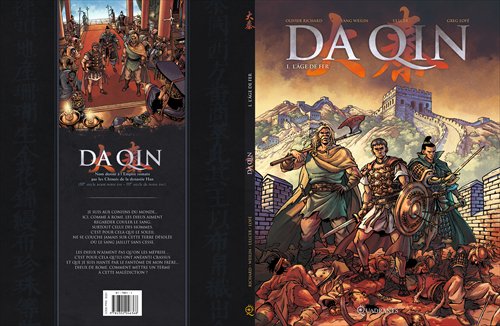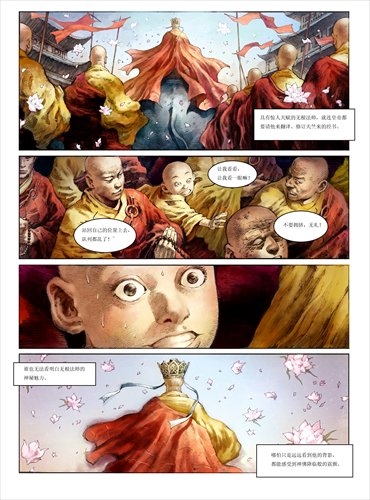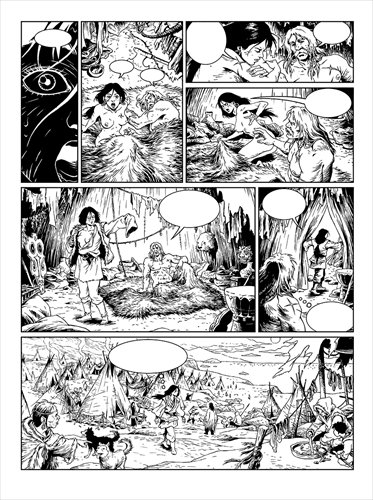China’s comic book artists big hits in Europe but struggling at home

Panels from Da Qin (top, middle) and The Temple Floating in the Sky Photos: Courtesy of Wang Ning

Panels from Da Qin (top, middle) and The Temple Floating in the Sky Photos: Courtesy of Wang Ning

Panels from Da Qin (top, middle) and The Temple Floating in the Sky Photos: Courtesy of Wang Ning
Doraemon, Arale, Seiya, Superman, Batman and Spider-man… no matter if it's Japanese manga or US comics, these names are no strangers to Chinese, even those who don't really pay attention to comics. But when Wang Ning threw up three pictures on the screen during a lecture at a comic book forum and asked the audience if they recognized anyone, all the experts and comic fans sank into silence.
The three images were drawings by He Youzhi, Liu Jiyou and Hua Sanchuan - legendary masters of traditional Chinese comics, or manhua.
"That is what we call the gap between Chinese manhua and the rest of the world," Wang said, sighing.
There is a saying in the world of Chinese manhua that the most talented manhua artists are currently drawing for Europeans. Although this is somewhat of an exaggeration, it's certainly true that manhua artists are seeing more success in Europe than at home.
Rising success
Examples of this success can be found everywhere.
Chinese manhua artist Li Kunwu just finished talking about his success in Europe at a comic festival in Changchun, Jilin Province. According to a report on news site cankaoxiaoxi.com, his work A Chinese Life was an immediate best-seller after it hit shelves in France in 2010. The work went on to be published in more than 13 countries including the UK, Germany, Japan and South Korea.
The current wave of success experienced by manhua artists in Europe can be traced back to 2006, when Chinese artist Benjamin (Zhang Bin) published his work Remember in France, making him the first manhua artist to sell Chinese comic books in the European market. Soon after, a number of Chinese artists followed step by targeting Europe as the platform to show off their talent.
These artists not only struck it big when it came to sales, but also earned recognition at many international-level festivals.
Li has recently been nominated for an award at the comic "Oscars" - the Angoulême International Comics Festival. In addition, The Temple Floating in the Sky by Zhang Xiaoyu won the top prize at an international comic festival in Chambery, France, which was voted on by French readers and TV stations.
Wang once took Zao Dao, a young manhua artist, to a comic festival in France. All 250 copies of her works that she brought sold out in just three hours.
"China doesn't lack world-class manhua artists," Wang said.
"But they need opportunities and a market."
Exploring a new market
So far, Wang has published more than 100 Chinese comic books in more than 10 European countries including France, Germany, Italy and the UK.
According to Wang, these works adopt a storyboard narrative-style that is easily understood to illustrate traditional Chinese content.
"Adults especially prefer works that can help them understand China. Li Kunwu's works are a good example of this," Wang said.
For example, Li's A Chinese Life explores the changes a Chinese mountain village undergoes over the course of 50 years and the consequences that arise from them.
Targeting Western readers, Wang first began publishing manhua versions of China's Four Great Classical Novels (Water Margin, Romance of the Three Kingdoms, Journey to the West and Dream of the Red Chamber), before moving on to stories featuring traditional Chinese themes.
Quantity over quality
While many Chinese comic books have received recognition the world over, back home these works were turned down by domestic publishing houses because they "wouldn't sell well."
Wang once visited four publishing houses with works that had done well overseas. While the editors praised the artwork, they refused to publish them.
"They told me they couldn't publish them because their main readers are kids," Wang explained.
In his opinion, the stereotype in China that comics are for kids is one of core reasons behind the sluggish comic book market.
"In China, I can say more than 80 percent of people still think comic books are only meant for kids," Wang told the Global Times.
Another reason is a lack of passion for creating high quality comics.
Zou Kai, managing editor of publisher Comic Stories, pointed out that since the launch of the Central Government's Project 5155 in 1995, which encouraged the creation of original Chinese animation for children, Chinese comics experienced a boost from 1995 to 2005, then a decline from 2005 to 2015, before falling into chaos.
Zou mentioned that nowadays, manhua artists in China can be divided into three levels.
The top level consists of those artists whose work can be appreciated at an international level. The second group are those who were influenced by Japanese manga and continue to publish series while guaranteeing the quality. However, the last and largest group consist of artists who just want to earn quick money, and so sacrifice quality for quantity.
"This may be the key reason behind the current chaotic nature of the Chinese comic book market, and also the reason behind some misleading impressions overseas," Zou said.
Wang agreed with Zou's assessment, "The annual output of Chinese animation in 1989 was 32,400 minutes. More than 20,000 out of that were quality works. Now more than 270,000 minutes of animation are produced a year, but not even 2,000 minutes of it is quality animation."
Newspaper headline: Not just for kids